EAPP- Q1- Module 5 - english PDF

| Title | EAPP- Q1- Module 5 - english |
|---|---|
| Author | Marie Sol Reyes |
| Course | English Major |
| Institution | Philippine Normal University |
| Pages | 23 |
| File Size | 1.3 MB |
| File Type | |
| Total Downloads | 61 |
| Total Views | 118 |
Summary
English for Academic and Professional Purposes – Senior High School Quarter 1 – Module 5: Outline Reading Text in Various DisciplinesRepublic Act 8293, section 176 states that: No copyright shall subsist in any work of the Government of the Philippines. However, prior approval of the government agen...
Description
English for Academic and Professional Purposes – Senior High School Quarter 1 – Module 5: Outline Reading Text in Various Disciplines Republic Act 8293, section 176 states that: No copyright shall subsist in any work of the Government of the Philippines. However, prior approval of the government agency or office wherein the work is created shall be necessary for exploitation of such work for profit. Such agency or office may, among other things, impose as a condition the payment of royalties. Borrowed materials (i.e., songs, stories, poems, pictures, photos, brand names, trademarks, etc.) included in this book are owned by their respective copyright holders. Every effort has been exerted to locate and seek permission to use these materials from their respective copyright owners. The publisher and authors do not represent nor claim ownership over them. Regional Director: Gilbert T. Sadsad Assistant Regional Director: Jessie L. Amin Development Team of the Module Writer
:
MA. CRISTINA V. CONDENO
Editors
:
GINA B. PANTINO SONIA V. PRENSADER JOSALIE T. TONIO LORAINE T. CHIONG
Reviewers
:
GINA B. PANTINO and Masbate Province Division headed by HELEN TITONG
Illustrator/Layout Artist:
JOHN MICHAEL SARTE, ANTONIO L. MORADA
SHS ENGLISH FOR ACADEMIC AND PROFESSIONAL PURPOSES Quarter 1 – Module 5 OUTLINE READING TEXT IN VARIOUS DISCIPLINE
This instructional material was developed based from the Most Essential Learning Competencies (MELC) in English for Academic and Professional Purposes in response to the new normal scheme in learning delivery of the Department of Education. This module was collaboratively reviewed by educators and program specialists in the Regional Office V. We encourage teachers and other educational stakeholders to email their feedback, comments, and recommendations to the Department of Education at ____________________. We value your feedback and recommendations.
Department of Education
Republic of the Philippines
1
Quarter 1 - Module 5
Outline Reading Text in Various Disciplines I.
Introduction
Well done, learner! Reaching this point means you are already equipped with basic strategies in reading for a better understanding of various academic texts. As you venture this lesson, you will apply what you have learned from the past lessons regarding academic texts, text structure, summarizing, and identifying thesis statements. In this module, you will learn the strategies in outlining reading texts in various disciplines. Maybe you already encountered the term ‘outlining’ before and your teachers asked you to make an outline of a text. If that’s so, you may find the activities on this lesson as a piece of cake! If not, don’t worry because the lesson and activities are made simple and understandable. Just follow the instructions and you will always be on track. Now let’s start crossing the exciting and fruitful journey of this module!
II.
Objective
At the end of this lesson, you are expected to: ●
Outline reading texts in various disciplines (CS_EN11/12A-EAPP-Iac-8)
III. Vocabulary list Let’s enrich your vocabulary with these terms that you will encounter throughout this lesson. ● ● ● ●
Outlining – summarizing the essential features of a text in hierarchical or logical order Skim – to look over or read quickly specially to find the main ideas Text – a piece of writing, written or printed material Thesis statement – states the purpose and/or central idea of a text
2
IV. Pre-test Now that you’ve got an idea on what you are expected to learn from this module, Let’s have first a warm-up. Directions: Read and comprehend the short text below. Then, complete the outline that follows by filling out the blanks with the correct words/phrases from the text. Write the answer on a sheet of paper. Noise Pollution Aircraft, traffic, construction, various machinery, and other facets of modern civilization create noise pollution. This excessive noise can harm human physically and psychologically. Diseases in hearing are a common result of noise pollution. After research confirmed that loud levels of noise reduced hearing, some cities passed laws setting the decibel level of music allowed in night clubs. Noise pollution can be reduced by either moving the source away from people or creating quieter machines. For example, the placement of airports away from the city reduces the noise pollution of the city. Better insulation of buildings against noise can reduce noise pollution inside a building.
I. Noise Pollution A. Sources of noise pollution 1. Aircrafts 2. Traffic 3. ____________________ 4. ____________________ 5. Other facets of modern civilization B. General effects of noise pollution on human beings 1. ______________________ 2. ______________________ C. Ways of reducing noise pollution 1. ______________________ 2. Creating quieter machines
V. Learning Concepts “The more that you read, the more things you will know. The more that you learn, the more places you’ll go.” —Dr. Seuss Indeed, reading provides indispensable knowledge and skills that will bring you to other dimensions of learning. Hence, outlining as a skill in reading, will be your vessel as you journey the realm of understanding academic texts. Are you ready to outline reading texts? Let us study outlining in the context of reading. 3
Before, you were told to make an outline prior to writing an essay or text (pre-writing). In this sense, the outline serves as your guide or blueprint in writing to ensure organization of your ideas; it is called as writing outline. In this lesson you will make an outline after you read a text (post-reading), it is called as reading outline. That means the outline will reflect the summary or abstract of the text. Therefore, you need to read and comprehend the text before you could make an outline. Now, let’s have a detailed grasp of this lesson. An outline is a summary that gives the essential features of a text. It shows how the parts of a text are related to one another as parts that are of equal importance, or sections that are subordinate to a main idea (Valdriz, 2017).
Steps in creating a reading outline
1 2 3
4 5 6 7 8
Read the entire text first. Skim the text afterward. Locate the thesis statement of the whole text. Look for key phrases in each paragraph of the text. Locate the topic sentence of each paragraph. Look at the topic sentences and group these with related ideas together. Arrange the contents according to levels. Evaluate the supporting details.
Go back to the text to check whether you have followed the sequence closely and you have not missed any important information
Outline provides a means of organizing your information in a hierarchical or logical order. For research papers, a formal outline can help you keep track of large amounts of information
You may follow the simple steps below in finalizing your outline. Place your thesis statement at the beginning. List the major points that support your thesis. List supporting ideas or arguments for each major point. If applicable, continue to sub-divide each supporting idea until your outline is fully developed.
4
Tip! When looking for key phrases such as major points and supporting details you may use a concept map to organize your ideas. For example:
Now, be familiarized with the appearance of an outline on the way how contents are labeled. When preparing an outline, you can either use a decimal outline or alphanumeric outline. A decimal outline only uses numbers as labels while an alphanumeric outline uses both letters and numbers as labels (Barrot, 2016).
Decimal Outline
Alphanumeric Outline
1. ___________________________ 1.1 ___________________________ 1.2 ___________________________ 1.3 ___________________________ 2. ___________________________ 2.1 ___________________________ 2.2 ___________________________ 2.2.1 _______________________ 2.2.2 _______________________ 2.3 ___________________________ 3. ___________________________ 3.1 ___________________________ 3.2 ___________________________
I. ___________________________ A. ___________________________ B. ___________________________ C. ___________________________ II. ___________________________ A. ___________________________ 1. _______________________ a. _____________________ b. _____________________ 2. _______________________ B. ___________________________ 1. _______________________ 2. _______________________ a. _____________________ b. _____________________ C. ___________________________ 1. _______________________ 2. _______________________ III. ___________________________ A. ___________________________ B. ___________________________ C. ___________________________
Between these two ways of outline labeling, which do you think is commonly used? That’s right, it’s alphanumeric outline.
5
Key points! Mechanics of Outlining (for Alphanumeric Outline) 1. Indicate main headings and subheadings using Roman numerals and capital letters. To divide the subheadings further, Arabic numbers are used. Fourth degree ideas are indicated by numbers and small letters followed by a close parenthesis. The descending parts of an alphanumeric outline are labelled in the following order: I. _________________________ A. ________________________ 1. _______________________ a. ______________________ 1) _____________________ b) _____________________ 2. 3. 4. 5. 6.
Place a period after each number and letter heading and subheading. Do not place a period after each number or letter with close parenthesis. Do not place a period after each item unless it is a complete sentence. Begin each item with a capital letter. Be sure that corresponding main divisions are of the same level of importance and that corresponding sub-divisions are of the same level of importance also. 7. Use parallel grammatical structure for headings. 8. Avoid the use of the words “Introduction”, “Body”, “Conclusion” to substitute headings.
Study the sample outlines, Outline A and Outline B, below. Outline A: Thesis Statement: Research shows that single-sex classes are better for girls and, therefore, should be encouraged. I. Background A. Segregated education B. Coeducation C. Title IX II. Gender Bias A. Attention 1. Opportunity 2. Discipline B. Favoritism 1. Encouragement 2. Expectation
6
III. Academic advantages A. Grade improvement 1. Materials 2. Methods B. Techniques 1. Math 2. Science IV. Personal advantages A. Distraction B. Comfort 1.Environment 2.Students C. Development 1. Self-confidence 2. Role models Outline B: Thesis Statement: Research shows that single-sex classes are better for girls and, therefore, should be encouraged. I. During the first 200 years in America, women were not allowed in schools. A. Initially, education was only for men. B. Throughout the nineteenth century, the number of coed schools increased. C. In 1972, Congress passed Title IX, a law prohibiting sex discrimination in educational institutions. II. One significant advantage of single-sex classes is the elimination of gender bias that often occurs in coed classes. A. Teachers pay more attention to boys. 1. Girls are not called on as often as boys in coed classes. 2. Many times teachers tolerate disruptive behavior in boys but discourage the same behavior in girls. B. Favoritism is also an issue in coed classes. 1. Teachers “get a thrill from involving a boy who’s going to be disruptive.” 2. Teachers have higher expectations for boys than for girls. III. Girls benefit from being free from the gender bias of coed classes. A. They perform better academically. 1. Textbooks “show an inherent and often inadvertent bias against females in textbooks.” 2. This bias also shows itself in teaching techniques. B. Techniques that are disadvantageous to girls are more apparent in certain subject areas. 1. Girls show more interest in math when taught in single-sex classes. 2. Girls also show more interest in Science subject.
What did you notice with the structure of content or entries of the sample outlines A and B? 7
The first outline (Outline A) consists of words and phrases; so, it is called as topic outline. The second outline (Outline B) is composed of complete sentences, therefore it is a sentence outline. How about the organization of entries in the sample outlines above? There are four principles that need to be followed in organizing the contents or entries in an outline. These principles are coordination, subordination, division, and parallel construction. The principle of coordination requires ideas of the same relevance to be labeled in the same way. The principle of subordination shows that minor details must be placed under their respective major details. The principle of division requires that no cluster should contain only one item. In short, if you have subheading 1, there should be subheading 2. Lastly, the principle of parallel construction requires all entries in each cluster to use the same structure and format. Now that you already know the concepts, apply these in the following practice tasks.
VI. Practice Tasks
A. Practice Task 1 Directions: Read the text below and identify the major topic of each paragraph. Choose from the choices provided after the reading text. Write the answer on a sheet of paper.
Fashion (1) Fashion is said to have a language that can be read like a text. It serves as an explanation of people's character, personality, lifestyle and values. It works by using signs and codes which are recognizable to others and transmit messages. These signs, codes and messages are called semiotics and influence all aspects of our daily lives. Semiotics in fashion works to convey our identity and in this way, messages can be projected to the outside world. (2) The earliest types of clothing were body painting and adornments. According to experts it is generally believed that the aim of these alterations was to modify the body in some way in order to communicate a specific message. In modern times the aim is largely the same, although the messages are more varied, complex and wide ranging. Nowadays it is common for people to use clothing, color, fabric, jewelry, hairstyles and even tattoos. Dr. Walker from The Centre for Fashion Studies asserts that how we style our bodies is one of the most important factors in defining the self. (3) Fashion is not only used to define the self but also is a powerful tool for group identity. This can be most clearly seen in youth fashion which is often given a name 8
to help convey the messages of its members. Fashion styles such as goth, mod and emo have semiotic signs and symbols which can represent values, beliefs and political ideologies. Often these values and ideas bring young people together who use clothing as a way to identify others who share their philosophy of life. (4) On the other hand, the semiotics of fashion can be seen as a product of a consumerbased society where appearance, especially through clothing, is valued and judged. This leads to people making conclusions about others on the basis of what they wear. These conclusions are often incorrect and damaging as they attach values and characteristics to people which they may not actually believe in or possess. (5) In conclusion fashion can be a useful way to analyze an individual, group, society or time period. Clothing and body adornment can highlight status, mood, ideas and values. Although semiotics has sometimes been criticized as a tool of judgment for appearance, it has generally offered a valuable insight into human thought and behavior throughout history. Paragraph Paragraph Paragraph Paragraph Paragraph
A. B. C. D. E. F. G.
1: _____________________ 2: _____________________ 3: _____________________ 4: _____________________ 5: _____________________
Connecting fashion and character Fashion as a tool for unifying people Fashion is a like a language The effect of consumerism on fashion Using fashion to develop cultural knowledge Explaining fashion with signs Fashioning the body for communication
Well done! Now that you know already how to identify major topics which is crucial in outlining, you are ready to outline reading text. Do you know where ‘writing’ started? Read on.
B. Practice Task 2: Directions: Read the text below and complete the topic outline that follows. Write the answer on a sheet of paper. Origins of Writing Ancient civilizations attributed the origins of writing to the gods. For the ancient Egyptians, their god Thoth was the creator of writing and, in some stories, also the creator of speech. The ancient Sumerians and Assyrians also believed that writing 9
originated with certain gods, as did the ancient Maya. In Chinese mythology, the creation of writing is attributed to an ancient sage and was used for communication with the gods. Clearly, writing was highly valued even by ancient peoples. Humans began painting pictures on cave walls 25,000 years ago or more; but writing systems did not develop until groups of people began settling in farming communities. Scholars say that writing systems developed independently in at least three different parts of the world: Mesopotamia, China, and Mesoamerica. The oldest known writing system developed among the ancient Sumerians in Mesopotamia around 3000 B.C. Along with the rise of agricultural societies carne the development of property ownership and the need to keep records of it. In early agricultural societies, property consisted largely of land, livestock such as cattle, and grain. Originally, clay tokens of various shapes were used to count these possessions. From this developed a system of impressing the shapes onto clay tablets. One of the earliest clay tablets of this type was found in excavations in Mesopotamia and dates from the time of the Sumerian culture. Scribes then began using reeds instead of tokens to mark the clay, developing a system of wedge-like shapes to represent the tokens. This system of writing using wedge shapes is known as cuneiform. It was later adopted by other cultures and became the basis for other writing systems. Originating in a system that used pictures to represent objects, cuneiform writing eventually developed into systems that used symbols to represent the sounds of language. The oldest form of Chinese writing dates from around 1500 B.C. It is called oracle bone script because it was carved on animal bones and shells that were used for predicting the future. At a later period, Chinese writing appeared on bronze vases and later still developed into a system that was used to record government affairs. The Chinese writing system was also the original basis for both the Japanese and Korean writing systems. In Mesoamerica, a region that encompasses parts of Mexico and Central America, it is the ancient Mayans who are famous for the writing they inscribed on temple walls and other religious structures. However, scholars believe that writing in that part of the world may have begun before the rise of the Mayan civilization. The Zapotec culture, centered on Oaxaca, Mexico, was already using writing around 400 B.C., or possibly earlier. The Olmec culture may have developed a writing system even earlier than that. Recent discoveries show that the Mayans may have begun writing around 2,300 years ago. They used a system of symbols that represented words and syllables to record information about the deeds of their rulers as well as information connected to their calendar and astronomy. Their system of writing survived until the time of the Spanish Conquest in the 1500s. In ancient times, only specialized people such as scholars, priests, or government officials used writing. Today, close to three-quarters of the world's adult population can ...
Similar Free PDFs

EAPP- Q1- Module 5 - english
- 23 Pages
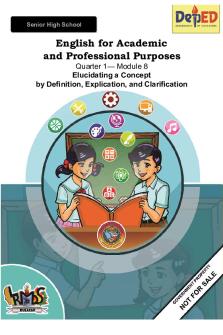
Final EAPP Q1 Module 8 - EAPP 11
- 30 Pages
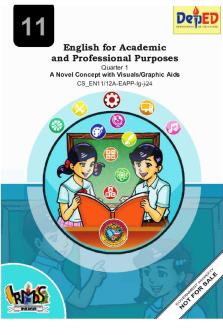
Final EAPP Q1 Module 10 - EAPP 11
- 24 Pages
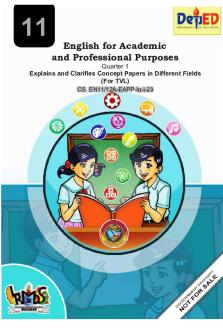
Final EAPP Q1 Module 9 - EAPP 11
- 22 Pages

EAPP- Q2- Module 5 - english
- 20 Pages
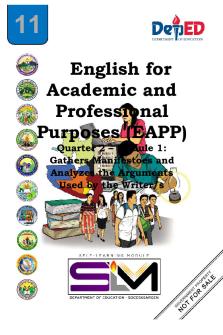
EAPP- Q2- Module 1 - english
- 22 Pages

EAPP Quarter 2 Module 5
- 70 Pages

EAPP Q2 Module 5 - Research
- 20 Pages

EAPP-Module-2 - Module
- 28 Pages

CW Q1 Mod2 - Module
- 15 Pages
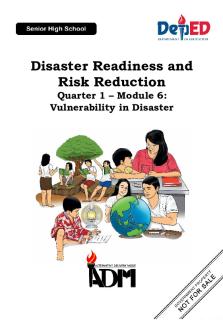
DRRR-Q1- Module-6-08082020
- 25 Pages

DRRR-Q1- Module-4-08082020
- 27 Pages
Popular Institutions
- Tinajero National High School - Annex
- Politeknik Caltex Riau
- Yokohama City University
- SGT University
- University of Al-Qadisiyah
- Divine Word College of Vigan
- Techniek College Rotterdam
- Universidade de Santiago
- Universiti Teknologi MARA Cawangan Johor Kampus Pasir Gudang
- Poltekkes Kemenkes Yogyakarta
- Baguio City National High School
- Colegio san marcos
- preparatoria uno
- Centro de Bachillerato Tecnológico Industrial y de Servicios No. 107
- Dalian Maritime University
- Quang Trung Secondary School
- Colegio Tecnológico en Informática
- Corporación Regional de Educación Superior
- Grupo CEDVA
- Dar Al Uloom University
- Centro de Estudios Preuniversitarios de la Universidad Nacional de Ingeniería
- 上智大学
- Aakash International School, Nuna Majara
- San Felipe Neri Catholic School
- Kang Chiao International School - New Taipei City
- Misamis Occidental National High School
- Institución Educativa Escuela Normal Juan Ladrilleros
- Kolehiyo ng Pantukan
- Batanes State College
- Instituto Continental
- Sekolah Menengah Kejuruan Kesehatan Kaltara (Tarakan)
- Colegio de La Inmaculada Concepcion - Cebu



